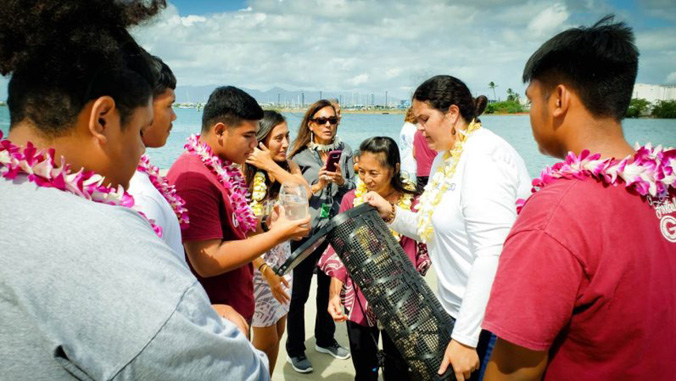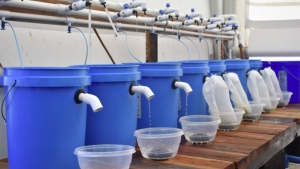
Native oysters cultured at the University of Hawaiʻi at Hilo Pacific Aquaculture and Coastal Resource Center will be used to improve water clarity and quality at Sand Island, Honolulu. At ceremonies in October to launch the project, baskets of oysters were placed in the water at Honolulu Community College’s Marine Education Training Center (METC) and the Polynesian Voyaging Society’s mooring area.
Students from Farrington High School‘s marine science classes contributed to the project by measuring and then placing the oysters in the water prior to a ceremonial blessing. Hawaiian prayer, chants and other protocols were also offered.
The oysters filter between 20 and 45 gallons of water per day, depending on their size, removing harmful pollutants including sediment, bacteria, heavy metals, PCBs (a group of toxic, man-made chemicals), oil, microplastics, sunscreen chemicals and nutrients from the water column, which improves water clarity and quality. This is the sixth Oʻahu location utilizing native oysters for water quality improvement.

“We also have [oysters] in Hilo Bay, which was the first place in Hawaiʻi where this was attempted starting in 2011,” said Maria Haws, director of the Pacific Aquaculture and Coastal Resource Center. “All of these are pilot efforts to obtain more data on growth and survival. The results have been good so far, so we’ll be expanding from 10,000 now out in the field to a total of 14,000 next month. Maui also has a site where we will use triploid Pacific Oysters with outplanting in December.”
- Related UH News story: UH Hilo center grows oysters and the aquaculture workforce, March 4, 2018
The oyster project to improve water quality at the METC was created through a collaborative partnership of UH Hilo, the Oʻahu Waterkeeper and the Polynesian Voyaging Society. The partners hope to encourage bio-remediation of the area’s waters and also to develop an educational program supporting these efforts. It was inspired by the Billion Oyster Project in New York Harbor, which Hōkūleʻa’s crew visited when the canoe sailed to New York City in 2016.
For more, visit the UH Hilo Stories website.
UH Hilo center grows oysters and the aquaculture workforce
—By Susan Enright

